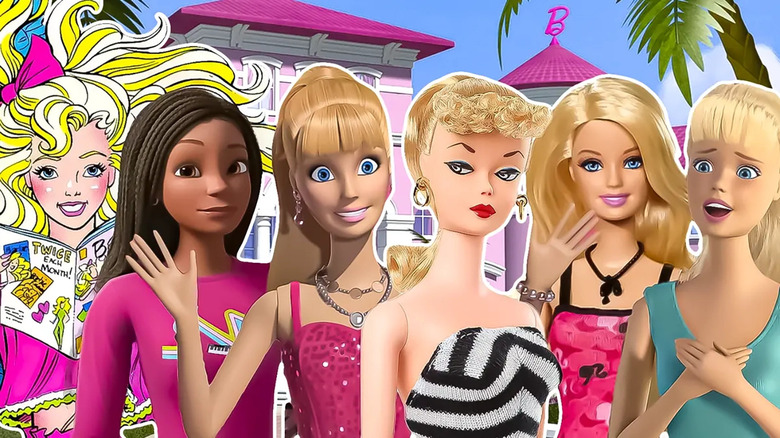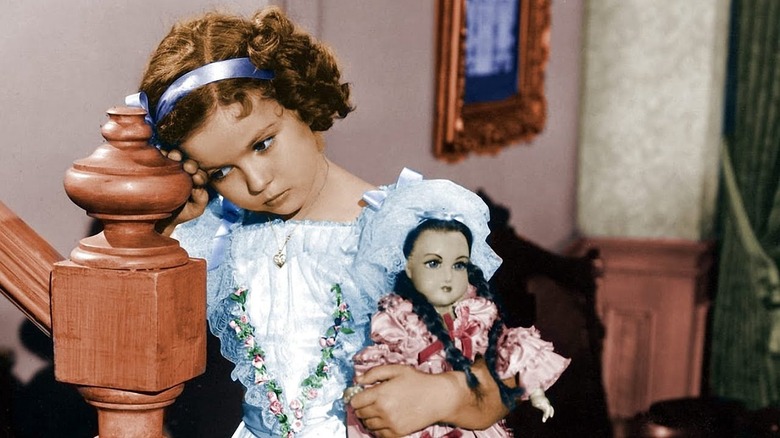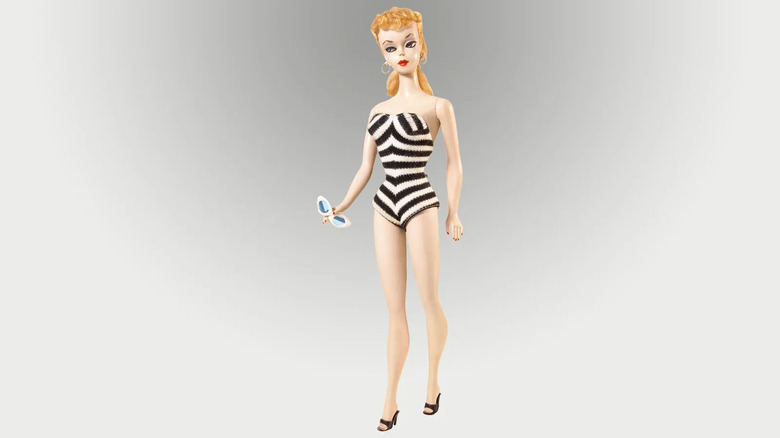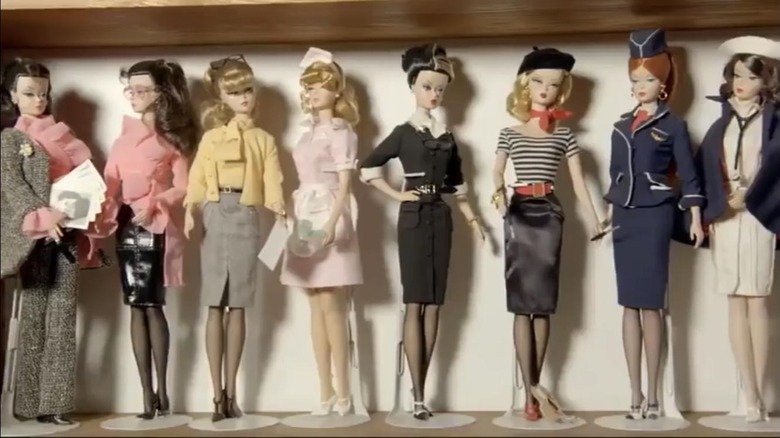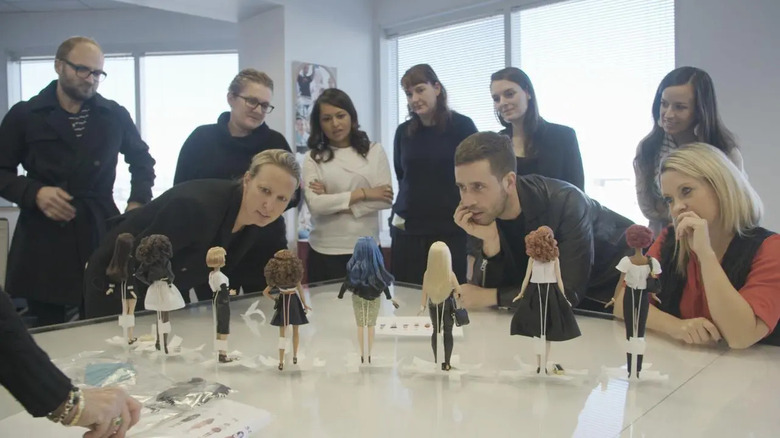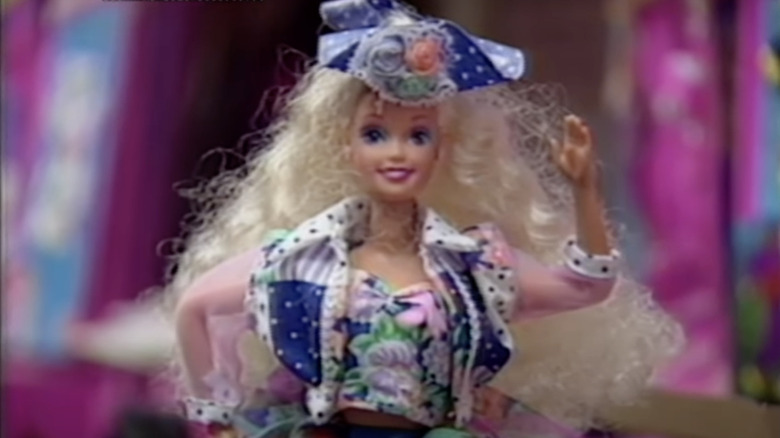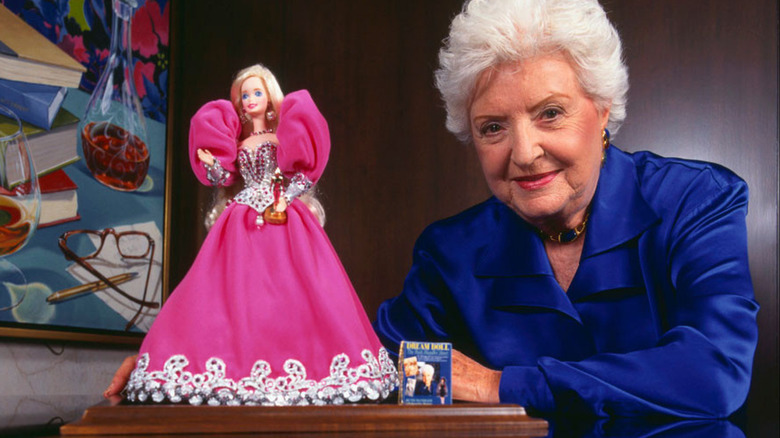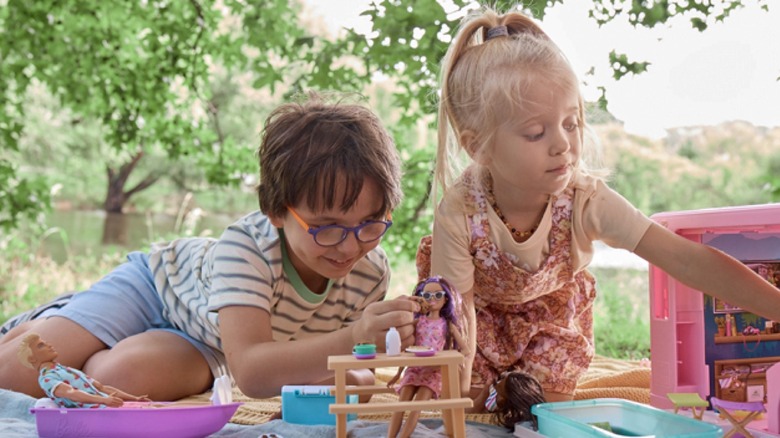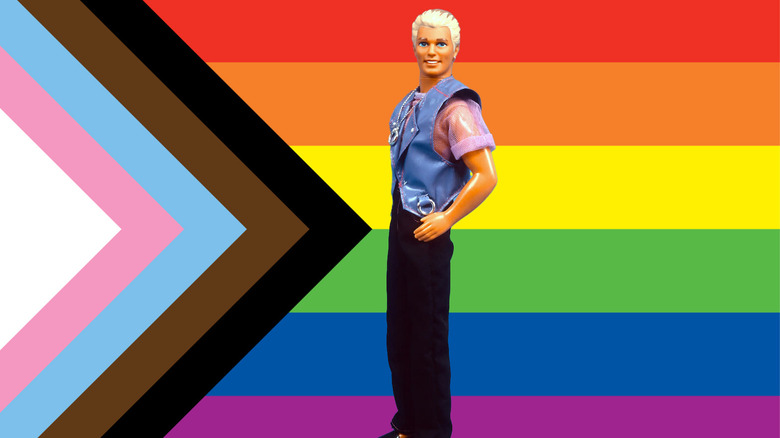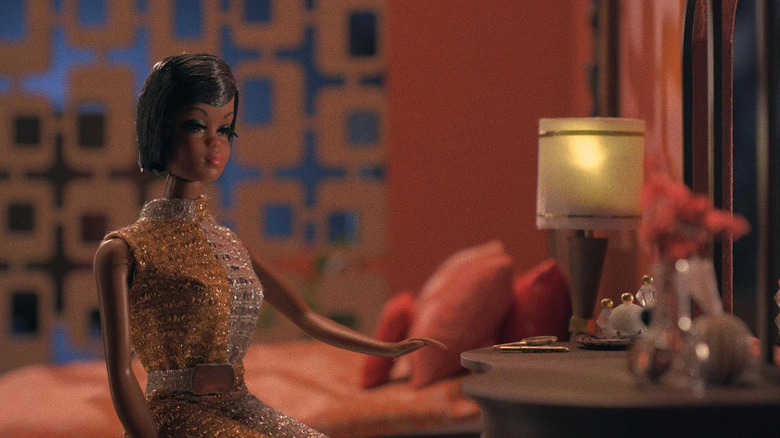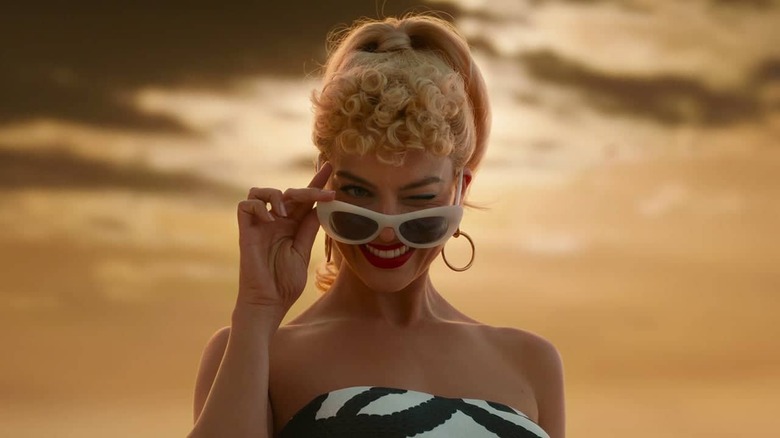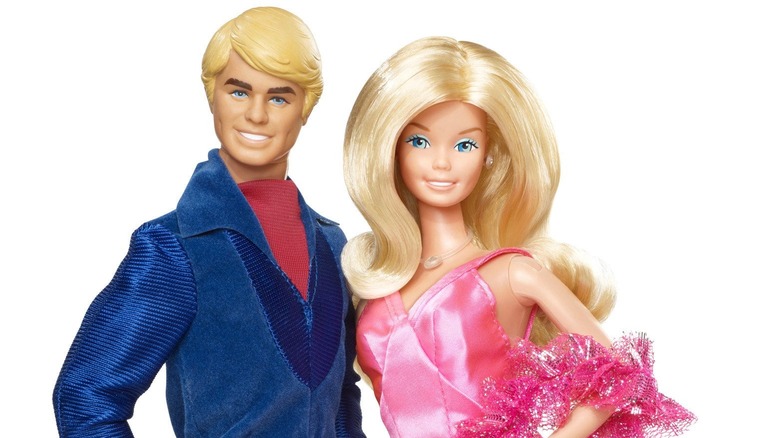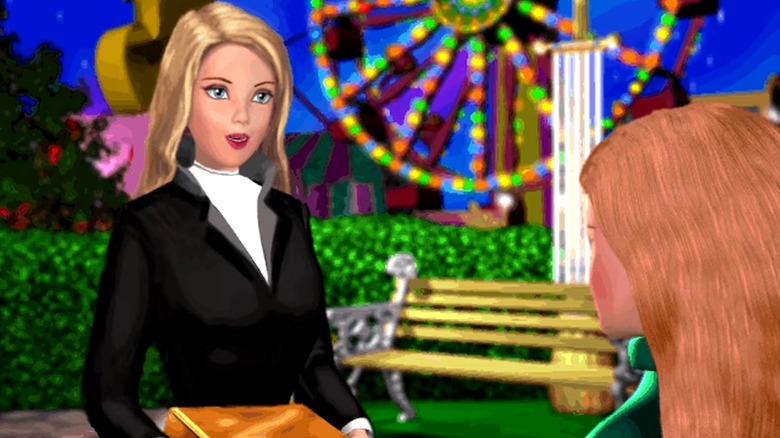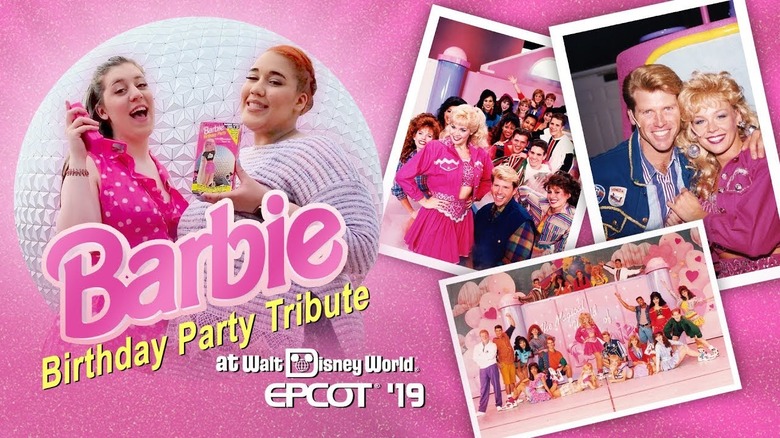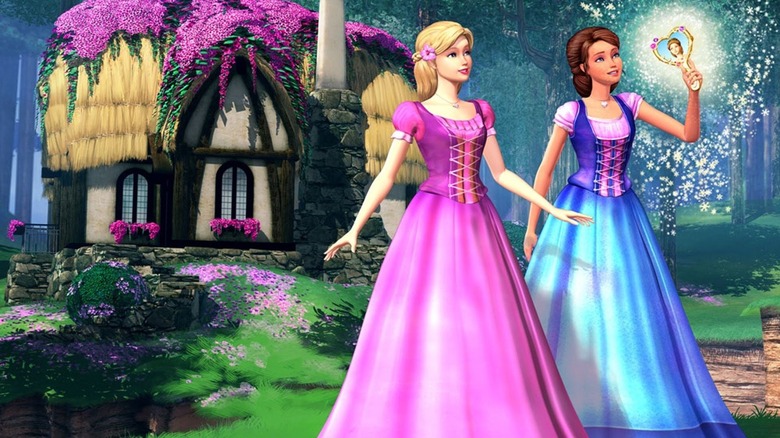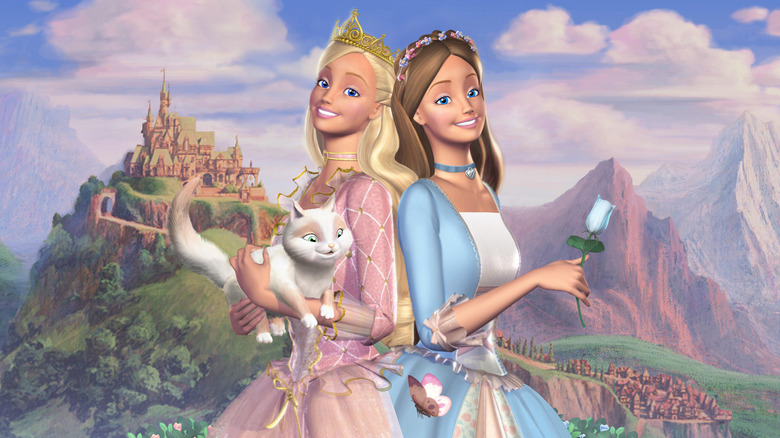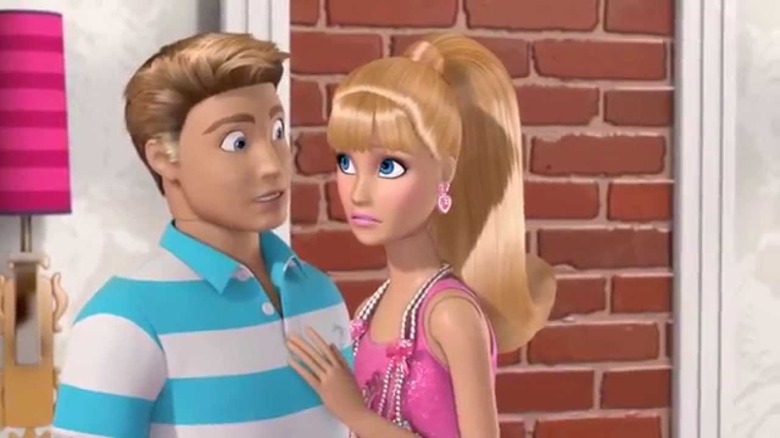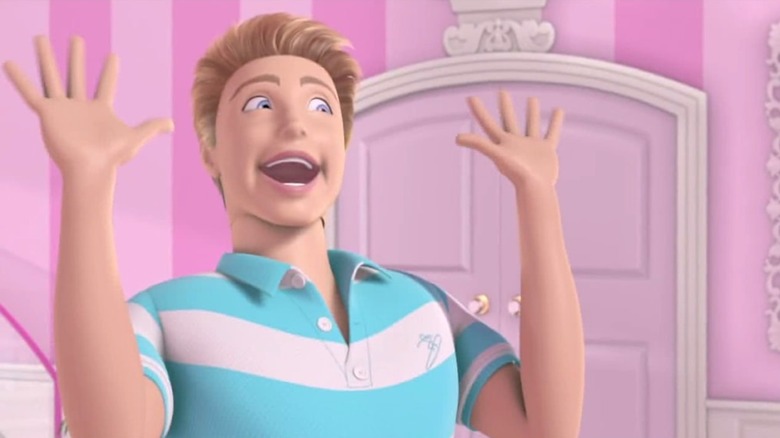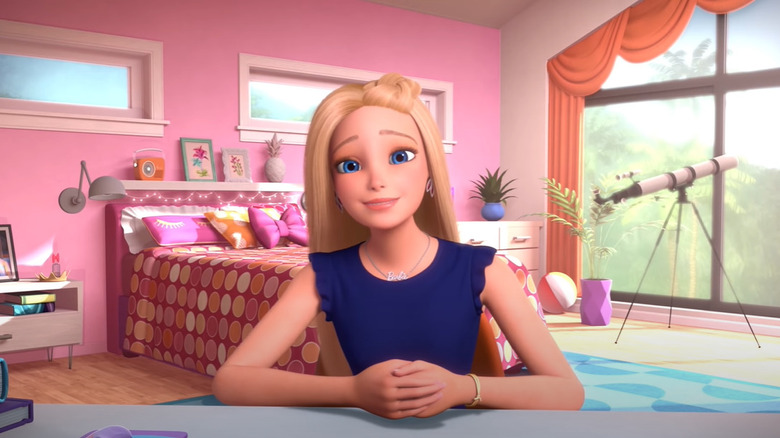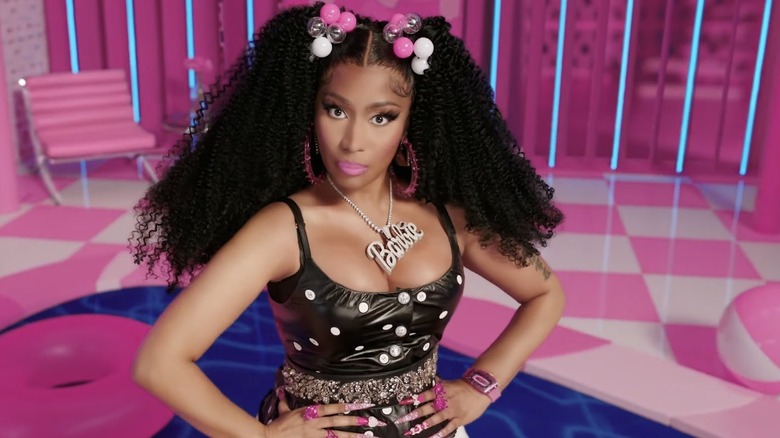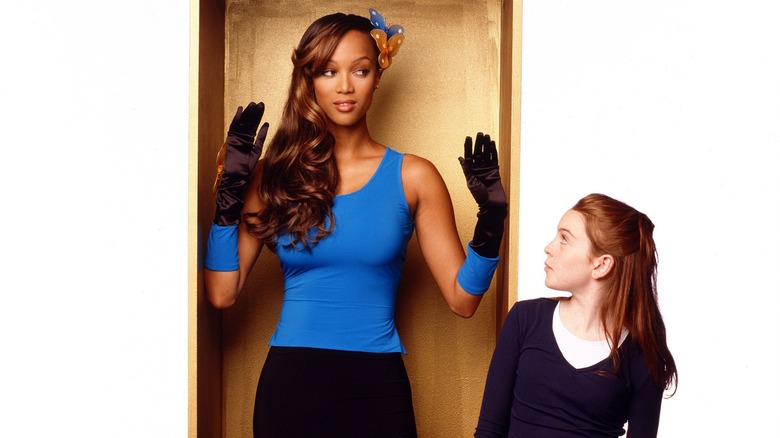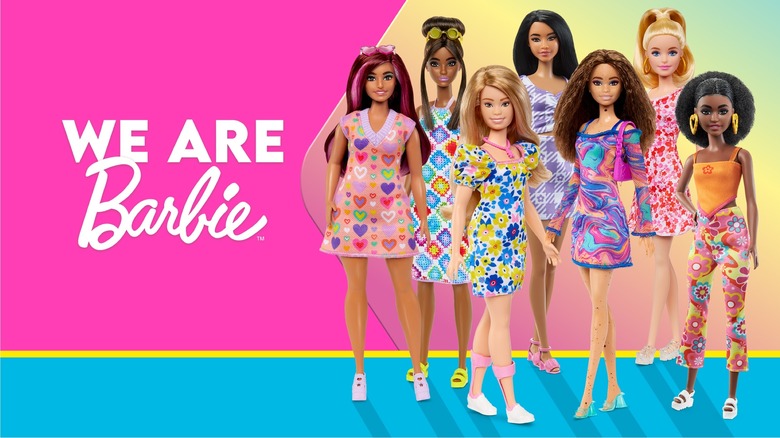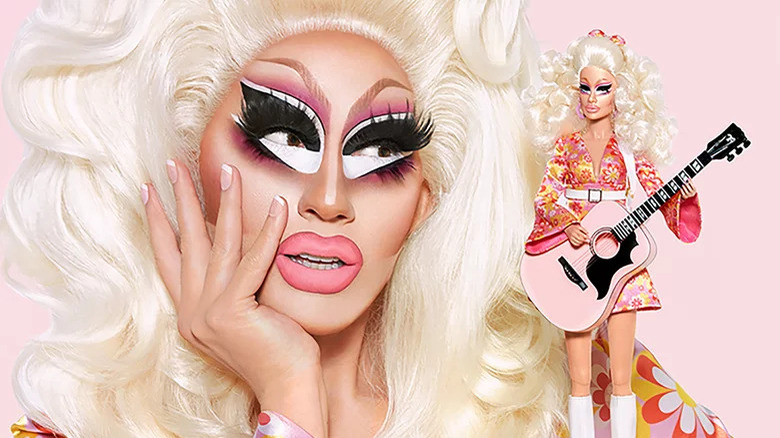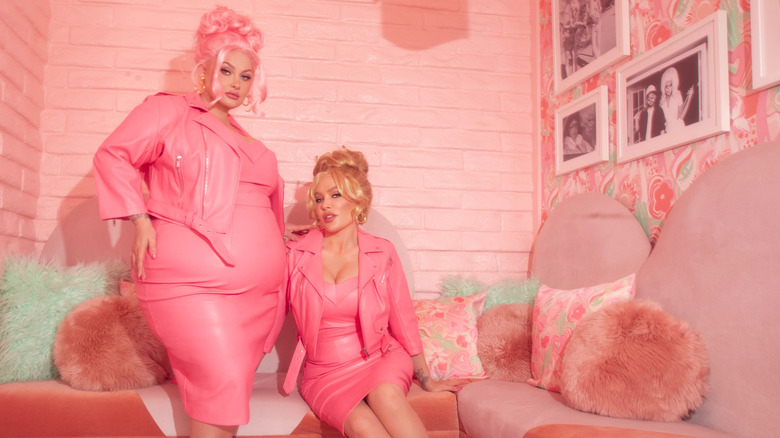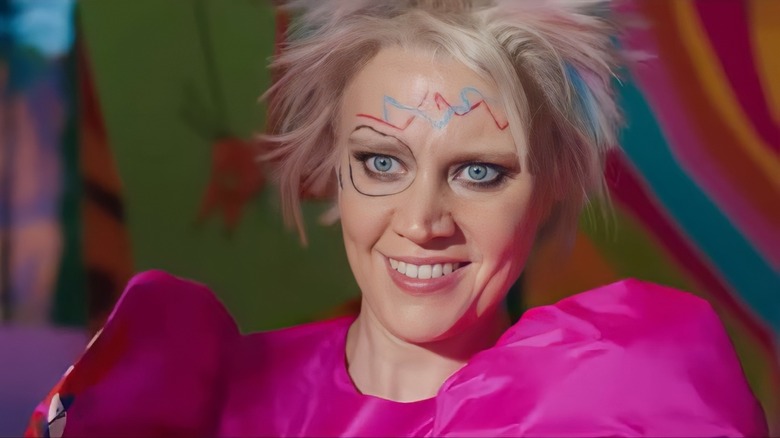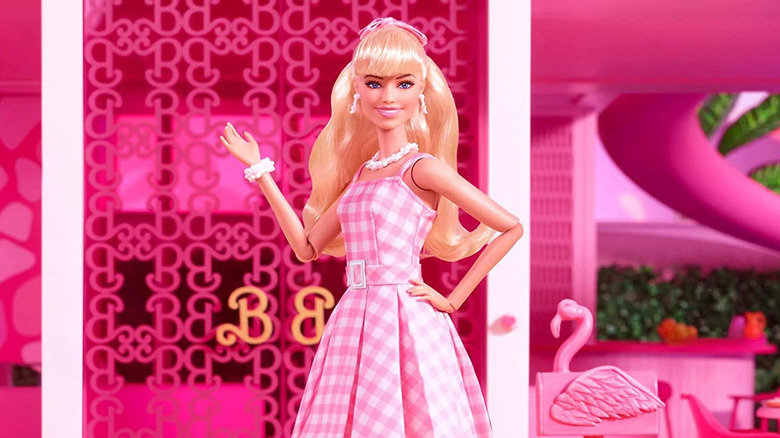The Only Guide To Barbie Lore You Will Ever Need
There are more Barbies in the United States than there are people. It's estimated that a Barbie doll is purchased every two minutes, and that doesn't account for dolls snagged second-hand. Barbie is a beloved childhood toy, an American institution, a cultural icon, and she can be used as a metric to track the way the world around her has evolved over time. "Barbie is too complicated for either an encomium or an indictment," said M.G. Lord, author of "Forever Barbie: The Unauthorized Biography of a Real Doll." And she's right. There's no one way to analyze Barbie, and no one-size-fits-all box to contain her. She truly is everything.
With Greta Gerwig's live-action "Barbie" movie still lingering as a cultural touchstone, it's high time that we celebrate one of the greatest figures of pop culture. Gerwig herself had to attend a "Barbie Boot Camp" before taking on the film, which is something many audience members could likely benefit from as well. Luckily for all of you reading at home, my obsessive fandom tendencies date back to childhood and I've consumed enough Barbie history over the years for many lifetimes.
Rather than provide an extensive look at the history of Mattel and Barbie ("Tiny Shoulders: Rethinking Barbie" and "Toys that Made Us: Barbie" already exist for that), I'm here to talk about the lore of Barbie. Between headline-making controversies in real life, endless merchandising crossovers, an expansive line of storytelling between film, television, and web-based entertainment, as well as the semi-universal experiences of growing up playing with the doll, consider this a crash course in the fantastic, plastic life of Barbie.
A brief introduction to dolls as a toy
Dolls were an important part of societal development in many of the earliest recorded cultures in history. Ancient Egyptians were known to have played with flat, paddle dolls used by children and as effigies in rituals. The ancient Greeks made posable dolls out of rope and clay, some of the earliest examples of what we now know as rag dolls. Other cultures have been known to make dolls from cloth, ivory, wood, soapstone, paper, or even apples, and they made clothing out of the leftover pieces of fur or leather that were used to clothe humans. As time moved on, dolls started to take different forms like marionettes, the famous Russian nesting dolls, and eventually porcelain dolls. Rhia, a doll historian who makes viral TikToks about Barbie and doll history, refers to these early dolls as the "homunculi era," because they often looked like toddlers in dresses.
But in the wake of the industrial revolution — when dolls were able to be mass-produced — the baby doll became the most popular, with dolls modeled after adults being pushed to the wayside by the 1920s. But because baby dolls are, well, babies, imaginative play was limited. Little girls were essentially using these dolls to mimic motherhood, and what should be a toy for enjoyment became a training device. There are certainly social-emotional benefits to teaching any child how to properly care for those smaller than them, but baby dolls, unfortunately, pushed traditional gender roles on little girls and motivated other toy companies to do the same. This is why so many playsets marketed toward little girls involve domestic work like cooking, cleaning, and nurturing others.
This history is important because it serves as a reminder that Barbie's arrival was revolutionary. No longer were children limited to "play mommy" with their dolls. They now had a doll that doubled as a motivational tool for themselves and their own imaginations.
The Barbie revolution
Barbie immediately looked different compared to the dolls that came before her. "They had chubby baby hands and chubby baby faces, and they were supposed to represent adults, but they did not look like adults because toy companies were afraid of making a woman's body," Rhia says. Barbie, unquestionably, looked like a grown woman.
Created by Ruth Handler and modeled after the "naughty" German adult gag gift doll named Bild Lilli, Barbara "Barbie" Millicent Roberts arrived on the scene in 1959 at the American Toy Fair as a fashion doll for children. Naysayers believed that children would never want to play with a doll with such "a figure," but children flocked to her. "They thought it was inappropriate for children, even though they were going to grow up into that [figure]," says Rhia.
While Barbie is known for her mega-watt smile and bright eyes, the original face mold featured a sideways glance as introduced with her black and white bathing suit-clad model. Barbie didn't look like a baby, so she didn't come with any preconceived notions attached about how to play with her. Imaginations went wild. "With Barbie, you're playing what's going to happen, or maybe made-up scenarios," Rhia says. "I don't know about you, but when I was a kid, it was always crazy drama when I played with Barbies."
"I was never a kid that wanted baby dolls and to play 'house,' I always found myself more interested in the fantasy of what life could be rather than what it was expected to be for me as a little girl," says filmmaker and fashion designer Micheline Pitt. "I loved the freedom this doll showcased, while also being extremely girly. She had the same duality that I wanted for myself."
The limitless possibilities of Barbie
Barbie was a fully-realized person complete with endless potential, fashion, and ambition. As Rhia confirms, little girls immediately loved Barbie because she wasn't a baby doll. "There comes the expectation that you're going to be a mother with baby dolls," she says. "With Barbie, it's your future." In 1961, Barbie was given her "ultimate accessory" in the form of a boyfriend, Ken Carson. Fun fact: Barbie and Ken are named after Ruth Handler's children Barbara and Kenneth. But because Barbie was meant to have limitless possibilities, she and Ken will never marry. All of those bride and groom dolls they've released over the years? Those were simply recreations of photoshoots they did as models, of course.
Two years later, Mattel introduced Barbie's first best friend, Midge, and then Barbie's little sister, Skipper, in 1964. Over the years, Barbie's other sisters, Stacie, Chelsea (named Kelly until 2011), and Baby Krissy, have been introduced, as well as a variety of friends of different races and ethnic backgrounds. Barbie also had twin siblings named Tutti and Todd, but they've not been part of the official Barbie canon for over 50 years.
"My whole philosophy of Barbie was that, through the doll, the little girl could be anything she wanted to be," said Ruth Handler. "Barbie always represented the fact that a woman has choices." Barbie was introduced as a fashion doll, but her multiple careers made her an aspirational figure, and a model for self-sufficiency. Barbie is unmarried and child-free by choice. And yet, Barbie has held every job on the planet, ranging from a server at McDonald's to the United States presidency.
Barbie's first doll house was produced in 1962, over a decade before women's mortgage liberation in 1974, when it was no longer legal for financial institutions to deny a single woman a mortgage on grounds of gender and marital status. Barbie's appearance has also evolved many times, most prominently in 1971 when her face mold was redesigned for her eyes to look forward. Her designs (as well as that of the Dreamhouse) often change to reflect the cultural trends of the era, like the big hair of the 1980s and the more inclusive body shapes of the new millennium (more on that later). In 2021, Mattel also introduced Barbie "Brooklyn" Roberts to the world, a Black doll from Brooklyn, New York that coincidentally has the same name as OG Barbie.
Both Barbies are besties, even sharing a dorm room together during a summer performing arts program, and Brooklyn Barbie is just as accomplished as the blonde.
Barbie's biggest controversies
As much as we all love Barbie, she's not been immune to backlash and controversy; both the well-earned and unfair. As Barbie can seemingly do it all, she's been criticized as a symbol of excess and materialism, and her body's proportions have been well-documented as being unattainable. "You always have people being like, 'If Barbie was a real person, she'd be 7 feet tall and her neck wouldn't be able to support her head,' and it's like, 'Well, yeah, she's a mannequin, she's a piece of plastic,'" says Rhia. "She's a stylized toy. She's not supposed to be a human. You're not supposed to make her resemble a human." This is all true, too. As is discussed at length in "The Toys That Made Us: Barbie," the thickness of Barbie's clothes (because they're the same thickness as human clothes) wouldn't work on a doll built to a human scale, which explains her proportions.
However, this controversial reputation didn't help things in 1963 when Babysitter Barbie was introduced, complete with a doll-sized book featuring the weight loss advice "Don't Eat," or the Slumber Party Barbie's scale locked at 110 pounds released in 1965. Though there are plenty (myself included) who argue that these are more of a reflection of the messaging that already existed in the media and not a Barbie-specific call to action to promote thinness. Regardless, it wasn't a good look.
A decade later, Barbie attempted to educate the masses about puberty with the Growing Up Skipper doll that would slowly increase the doll's height by cranking her arm. Weirdly, cranking the arm also increased the size of her bust. Judy Blume's "Are You There God? It's Me, Margaret" was published just five years prior, and considering the moral panic that accompanied that book, it's unsurprising that this doll also came under fire. The doll was designed by a well-intentioned albeit totally missing-the-mark man ... because Ruth Handler had recently left Mattel following charges of fraud and false reporting to the U.S. Securities and Exchange Commission.
Barbie's talking troubles
"There's a misconception that Barbie is one finite thing," says TikTok creator and doll enthusiast Jeffrey Steinman. "I think people like to oversimplify her significance and blame their parenting mistakes and insecurities on her instead of stepping back and seeing the opportunities she provides." While Barbie is not above criticism, I agree with Steinman, wholeheartedly. But activist groups have always felt some kind of way about Barbie — typically negative. As famed feminist and journalist Gloria Steinem said in the "Tiny Shoulders" documentary, "I am so grateful I didn't grow up with Barbie." To each their own.
There were plenty of Barbie critics in the 1960s and '70s as second-wave feminism gained popularity, but the Barbie Liberation Organization (BLO) in the 1990s made mainstream headlines after switching the voiceboxes of Barbies and G.I. Joes in stores to showcase the ridiculous gender stereotypes encouraged by children's playthings. This meant G.I. Joes said things like, "The beach is a fun place for summer!" Meanwhile, Teen Talk Barbie was saying, "Vengeance is mine!"
While we're on the subject, Teen Talk Barbie had her own controversy for containing the pre-recorded phrase, "Math class is tough!" The intention behind the statement was to validate the difficulty many children have with math class, but concerned parents and activist groups worried that it perpetuated the stigma that girls have no place in STEM (Science, Technology, Engineering, and Math) subjects. It's a complicated situation, for sure, where the intent behind the inclusion of the phrase was decimated by the negative impact.
Only having one major talking incident is impressive, especially since Barbie talked all the time in games, toys, and other assorted products with no problem. She was predominantly voiced by Chris Anthony Landsdowne, whose "Barbie voice" is still the one many voiceover artists try to emulate even today.
Is the body image controversy even real?
Interestingly, a lot of the so-called "outrage" surrounding Barbie appears to be rooted in moral panics and projected fears of adults who didn't grow up with Barbie or from those who haven't unpacked their own internalized issues. As comedian and TV writer Ashley Ray wrote in a viral tweet, "I simply did not give Barbie this power over me. I controlled HER life. I had her man cheating on her, had her tied to my ceiling fan like it was a roller coaster ride, what could she do to make me feel bad?" The replies to the tweet also paint a story much different than what is often shown in documentaries or so-called "shocking" exposés on Barbie.
By and large, it seems like the majority of people never actually felt bad about themselves because of Barbie. Society and mean girls at school? Definitely. But Barbie? She seems to be collateral damage in the culture wars.
"My toys, to me, were toys, and they were incredibly important and special to me, but I knew that Barbie was a character and not a living breathing person," says Micheline Pitt. "Barbie was like a cartoon or art that was an exaggerated version of real life and people, so I never felt like I needed to look a certain way because of my Barbie, that happened at school amongst my peers."
I can only speak from my own personal experiences, but I was always bustier, fatter, and shorter than a majority of my classmates, and Barbie never made me feel bad about the way I looked. Barbie is a doll, a friend, and I'm not Barbie because I'm a human being. "That awful body image came from teen magazines and countless other magazines that I faced when I went with my mother to the grocery store, [magazines] that spent the better part of the '90s and '00s shaming women constantly for what they looked like," says Pitt. "Barbie told me I could be anything, that I could play and build worlds. It gave me creative freedom from a box the rest of the world so desperately wanted me to fit into."
Honestly, if there was ever a toy that made me "feel bad" growing up, it was the American Girl doll, because it was a price-prohibitive toy. No shade, American Girl. I was just poor!
Adult influence impacting childhood play
Dissecting whether or not Barbie is "bad" is a chicken/egg situation. Because we live in a patriarchal, heterosexist, fatphobic, ableist, white supremacist society, it is literally impossible to determine what negative messaging children are absorbing simply because they're surrounded by it from entertainment, the media, and their own parents' hang-ups since birth. It's similar to how little kids won't start crying after they've gotten hurt until an adult starts to panic, indicating to them that they should also be panicking.
A 2006 study is often shared as "proof" Barbie is bad for girls' self-image, but no one ever interrogates the imperfection of the study. In it, girls were given an Emme doll, a toy with more "realistic" proportions. This immediately would skew the data, because Emme dolls don't have the cultural baggage or immediately identifiable iconography as Barbie. In order for the study to work, they'd need to test with a bigger-bodied doll with a recognizable Barbie face mold. And they sort of did.
There's a moment in the "Tiny Shoulders" documentary where Mattel offers their new "Curvy Barbie" for girls to play with, and the children all call her "fat" and claim to not like her as much as the original Barbie. That's a sign that the problem is not Barbie, it's a fatphobic society that encourages the demonization of bigger bodies.
Of course, there are exceptions to every rule and I don't deny there were some girls who did feel some kind of way about Barbie, but based on my own decades of observation (which includes working with elementary school-aged children for much of my adult life), little kids typically aren't having an existential crisis about their dolls being an unattainable beauty standard. They're playing with their toys and don't internalize any of these so-called "issues" until an adult tells them they should or if they are pressured by their communities to feel a certain way.
Our society puts all sorts of impossible restrictions and standards on women, and that's the world these kids have to live in, whether they play with Barbie or not.
The 'gay Ken' controversies
Not to be outdone, Ken has also had some controversies of his own. His mere existence is a problem for some tightwads who think there's something inherently "feminine" about Ken for being a "doll" and not an "action figure," despite the fact Ken is built pretty damn similarly to an early G.I. Joe. Some naysayers have an issue with his lack of genitalia and view it as "emasculation." Ironic that the types to throw a fit about a dickless doll are also the ones who try to claim queer people are "grooming" children by merely existing. They've also taken issue with his lack of body hair, which is just an admittance that they never played with Barbie Shaving Fun Ken w/ Magic Color Change Beard & Accessories. How embarrassing to be them!
But the queer accusations don't stop there. When the Allan doll was first introduced in 1964, he was named "Ken's Buddy Allan" and had the selling point that "all of Ken's clothes fit him." Obviously, this was a marketing tool to appeal to buyers who might have been fearful that an Allan doll would require a whole new wardrobe, but it accidentally implied that Ken and Allan were lovers, since words like "buddy" and "special friend" were socially being used in place of "boyfriend" or "partner," despite the fact that Allan was actually Midge's boyfriend.
There's also the issue of Sugar Daddy Ken. For those unaware, Ken's West Highland Terrier is named Sugar. Mattel waved their hand at it all because "He's Sugar's daddy," meaning Ken is a dog dad. Riiiiiight.
But the ultimate gay Ken controversy was with Earring Magic Ken, a 1993 doll where Ken sported blonde highlights, a lavender mesh shirt, a necklace with a circular charm, and, of course, an earring in his left ear. Regardless of Mattel's intentions, Earring Magic Ken looks like a Circuit Queen, and gay men bought him in droves. He is still the most-purchased Ken doll in history because of it. Controversy or not, Earring Magic Ken is an icon in the LGBTQIA+ community, providing just as much representation for queer play as my fellow baby sapphics who made their Barbies scissor without knowing what it was or practicing how to kiss with the 38-inch-tall My Size Barbie.
I am absolutely speaking from experience.
Issues with representation
Mattel made history when they introduced Christie, the first Black doll in the Barbie line all the way back in 1968, but the company has certainly had some missteps when it comes to representation. In 1997, Barbie partnered with Oreo for a branded line, failing to recognize that calling a blonde, white Barbie "Oreo Fun" doesn't have the same social connotations as calling a Black Barbie the same name. Director Lagueria Davis is currently screening her documentary film "Black Barbie" on the festival circuit, a three-chapter film analyzing the history of Black Barbie dolls and their impact on society. I've not seen it yet, but it's one of my most anticipated films of the year.
Also in 1997, Mattel released Share-a-Smile Becky, Barbie's first friend who used a wheelchair. Unfortunately, Becky couldn't fit through the door of Barbie's Dreamhouse with her chair, because ADA compliance clearly wasn't considered when designing the playhouse. (This was luckily changed in 2021.)
There's also the Happy Family version of Midge that was nine months pregnant and came complete with a plastic belly cover and a newborn baby inside that could pop out. Some parents thought it was going to encourage teen pregnancy as Midge wasn't wearing a wedding ring (Oh my god, grow up!), while others found the doll to be a body horror nightmare. Emerald Fennell will be playing this version of Midge in Gerwig's "Barbie" movie, and while it's assumed the baby is fathered by Allan, it's never actually been confirmed.
As for Barbie's most recent controversy? Outside of bigoted idiots freaking out about the more diverse offerings and designs, the latest uh-oh was the sticker book "Barbie: I Can Be a Computer Engineer" in 2010, because instead of Barbie coding her own game and showing girls that they too can be computer engineers, Barbie relies on the help of her male friends to actually execute the necessary tech. "I'm only creating the design ideas," Barbie says in the book, laughing. "I'll need Steven's and Brian's help to turn it into a real game."
Despite popular belief, Barbie is not perfect and has certainly made plenty of mistakes over the course of her life. If you ask me, that makes her even an even better role model.
Meet Barbara Millicent Roberts!
It's important to remember that there is a difference between Barbie the brand and Barbie the character. The original Barbie was offered with blonde or brunette hair, but the blonde Barbie is the character that has served as the main character for decades. Gerwig's film lovingly refers to her as "Stereotypical Barbie." Her first job was as a teenage model followed by a fashion designer, but her penchant for holding every career under the sun began in 1961 when she became a registered nurse.
According to her canonical biography, Barbie grew up in the fictional city of Willows, Wisconsin, but fell in love with Malibu, California, which is now her home base. The location would become the setting for the series "Barbie: Life in the Dreamhouse," and has been the canonical home of Barbie since the Malibu Barbie doll was introduced in 1971.
Over the decades, Barbie has held over 200 jobs (she was even an astronaut before Sally Ride became the real first female astronaut) and has raised over 40 pets, including exotic animals like a panda, a lion cub, and a zebra. Hilariously, the Barbie Potty Training Tanner Doll that came with a small Labrador Retriever had to be recalled, because the dog would "poop" out little pellets for kids to scoop up ... which became choking hazards. Tanner's sibling Taffy is still Barbie's beloved pet (along with Tawny the horse and Blissa the cat). And movie lovers will be thrilled to learn that her favorite movie is "Sad and Romantic: The Sequel." (This is not a real movie any of us can see.)
Despite being one of the most well-known citizens of Malibu, Barbie is friendly, good-natured, and earnestly humble. She's a very loyal friend and tries her hardest to keep the people in her life happy (sometimes to a fault). But unlike the way most non-Mattel brands portray her, Barbie also sometimes struggles with insecurity and big emotions, and she isn't afraid to dump Ken when he needs to get it together and be a better boyfriend.
What about Ken?
Kenneth Sean "Ken" Carson was introduced as Barbie's boyfriend, and the story goes that the two met when they were hired to work on the same television commercial. The pair quickly fell in love and began dating, but their relationship is far from perfect. Barbie is a busy lady, and Ruth Handler stated many times that their relationship was always going to be on-again, off-again. In their first year of dating, Barbie was a ballerina, flight attendant, singer, and nurse, which doesn't really leave much room for a relationship. The two didn't move in together until 1974 with the introduction of a three-story townhouse, but Barbie's name is always the only one on the lease. Ken became the ultimate arm candy during the "Superstar Barbie" era that followed, and yes, some parents flipped out that the two could possibly cohabitate before marriage. (Again, GROW UP!)
Ken has a little brother named Tommy who sports a terrible bowl cut — he was introduced during the 1990s, arguably the worst decade of men's haircuts — and Ken's best buddy, Allan, was discontinued for a bit before returning as "Alan." (It's because the "Allan" name was inspired by Ruth Handler's son-in-law, who eventually was divorced by her daughter Barbara.)
Barbie and Ken have rallied between independent figures and a together-packaged couple numerous times over the years, but their most prominent break-up happened when Barbie dumped him on Valentine's Day in 2004. To be fair, she was running for president that year, and Ken's lack of commitment was getting in the way. In 2006, Ken received a makeover from celebrity stylist Phillip Bloch in an attempt to win her back. The two wouldn't officially get back together until Valentine's Day in 2011, which means that they were canonically not a couple when we saw them pop up in "Toy Story 3."
Ken's entire purpose has been to serve and support Barbie and her dreams, which is why it was so funny when people flipped out over the "Barbie" movie tagline of "She's everything. He's just Ken." It's proof-positive that the people getting upset didn't actually understand the lore. This is how it has always been. He's always just been Ken.
Barbie enhances 'geek' circles!
Did you know that Barbie has the potential to join the Marvel Cinematic Universe? I'm half-kidding, but it's fun to know that while Barbie produced a series of comic books through Dell Comics in 1962, she also appeared in a series of 63 issues of Marvel Comics from 1991 to 1996. As of 2016, Papercutz has been the exclusive publisher of the Barbie series of graphic novels, which tend to serve as tie-ins to other aspects of Barbie media, like web shows and direct-to-DVD movies or high-profile doll releases.
This means there are over 100 different adventures of Barbie and her friends' lives, so the previously mentioned biographies are just the most universally accepted parts of the canon. In superhero terms: Barbie is her own multiverse.
But it's the Barbie series of video and computer games, all 70 of them, where she truly shined in geek circles. Sure, there are the expected fashion, design, makeover, and dress-up games that take the physical play of Barbie into the virtual worlds, but Barbie games cover a vast spectrum of genres. Many of the games were promotional tie-ins, but even still, "Barbie and the Three Musketeers" is an action-packed, Metroidvania-style game. Yes, that means you can fight bad guys in a Barbie game.
If you ask a diehard Barbie fan what the best game is, the answer will likely be one of the Detective Barbie games. The series began with the 1998 PC point-and-click adventure game "Detective Barbie In the Mystery of the Carnival Caper!," a game I played so much as a kid I almost destroyed the family desktop. The success spawned two sequels: "Detective Barbie 2: The Vacation Mystery for PC" and "Detective Barbie: Mystery Cruise" for the PlayStation. Video games have historically been marketed with boys in mind, but as Broads at Yale pointed out, "The Barbie games allowed girls to enjoy stereotypically feminine pastimes in a way that encouraged creativity."
For additional reading, I highly recommend Nicole Carpenter's oral history of "Barbie Fashion Designer," the first mass-market 'game for girls' over at Polygon.
Barbie gets a show at Disney!
If you're a child of the '90s, you might have deeply rooted memories of watching "Barbie Birthday Party at Walt Disney World Epcot '94" on VHS. The video was a promotional tie-in event for the new "Magical World of Barbie Stage Show" show at Epcot and was sold for a single penny with the purchase of specific Barbies at the time. Hosted by Barbie's "hip new friends" Lisa and Stephanie (these are human girls, for the record), the two go behind the scenes of the show and explore the different areas of Epcot, all culminating with a birthday party for Barbie attended by her biggest fans, regardless of gender. (If you're the little boy in the Goofy hat wishing Barbie a happy birthday, please know that you are an icon in the Barbie fandom.)
The actual live show at Epcot came about after Barbie was named an "Ambassador of Friendship" for her cultural relevance across the globe ... and because Mattel sponsored It's a Small World at Magic Kingdom and Toys Fantastic at the Disney Village Marketplace. Running at only 20 minutes, "The Magical World of Barbie" was performed at American Gardens Theater in front of the American Adventure in World Showcase several times a day, and featured live music, dancing, and even a fashion show to showcase stylings from around the world. Over 300 women auditioned for the role of Barbie, who was eventually played by Miss Oregon 1993, Elizabeth Simmons.
Due to the show's short time on stage, there were countless Friends of Barbie who were unable to see the show live, but the VHS celebration became a childhood staple. Emmy Award-winning filmmaker Tammy Tuckey even created a small mini-doc in 2019 for the show's 25-year anniversary, tracking down those that were involved in the production as well as making a trip to Epcot to recreate memorable moments from the VHS special.
The Barbie show wasn't just a one-off gimmick, it was a treasured experience that is still remembered fondly over a quarter of a century later.
Barbie is a movie star!
As of publication, there are over 40 different direct-to-video animated Barbie films to varying degrees of merit. The franchise began with the release of two animated TV specials in 1987: "Barbie and the Rockers: Out of This World" and its sequel, "Barbie and the Sensations: Rockin' Back to Earth." Barbie also joined the VHS workout tape craze in 1992 with a terrifying CGI Barbie helping teach kids how to do dance aerobics, and it even features a young Jennifer Love Hewitt! But the mainstream film series began in 2001 with the direct-to-video release of its first feature-length film, "Barbie in the Nutcracker."
Tim Kilpin, then-senior vice-president for girls marketing at Mattel, stated in a 2004 article in Brand Strategy, "What you see now are several different Barbie worlds anchored by content and storytelling. A girl can understand what role Barbie is playing, what the other characters are doing, and how they interrelate. That's a much richer level of story that leads to a richer level of play."
Considering I watched many of the animated Barbie films as a tween, it's difficult to differentiate between a "good" Barbie film and one that I enjoy because it elicits a feeling of nostalgia. Fortunately, the Cult Popture podcast, hosted by Alexander "AJ" Jones and Richard Martin, did the Pink Lord's work by watching all of the animated Barbie features and recording an 18-hour podcast about it. The show frequently covers full film franchises, and Barbie was labeled "The Forbidden Franchise," considering she's got nearly double the number of films of James Bond.
"These are not movies made for us," says Jones. "We give them a fair shake, but at the end of the day, I can feel the voice of the filmmaker not looking at me, not talking to me." Fortunately, rather than writing the films off as girly schlock, the Cult Popture hosts powered through and were better for it. "It didn't feel very catered to us until it did," says Jones. "There are moments where I think the filmmakers themselves were going stir-crazy, and so they'd throw in jokes and references that, theoretically, 30-year-old men could enjoy."
The life-changing gospel of the Barbie movies!
"I think we were a little naive when we started about what we were getting into, because I was expecting just your Rapunzels and your Thumbelinas or whatever," says Martin. "I was expecting 37 (at the time) movies of just retellings of fairy tales." As for Jones, the impact of Barbie came out of nowhere. "I remember talking specifically about dealing with disappointment in life, then the next Barbie movie we watched was about dealing with disappointment in your life, and it was profound," Jones says. "It was like, 'Wow, we've accidentally created a narrative arc for our 18-hour podcast that was completely unintentional and by accident.'"
Jones' favorite film in the series is "Barbie as the Princess and the Pauper," which features the all-time great Barbie tune of "Girl Like You," but also has a soft spot for "Barbie & the Diamond Castle," which is universally accepted by Barbie fans as "the sapphic one." For the record, these are two of my personal all-time favorites as well. "My hottest take is I really like 'The Barbie Diaries,' which is widely regarded in the fan base as one of the worst," says Martin. "But, yeah, 'Diamond Castle' is the obvious favorite for me." Neither man expected much out of the Barbie films, but Martin found himself getting caught up in the excitement of it all.
"I was a big fan of 'Mermaid Tale,'" he says. "I remember having a point when I saw the next film we were watching was 'Mermaid Tale 2' and I felt legitimately excited for a moment and then realized, 'What am I doing with my life?'" There's an old saying in Hollywood that "girls/women will watch anything but boys/men won't watch shows for girls/women," and while there is some tragic, sexist truth to that, Jones and Martin are proof that consuming media that wasn't made with you in mind can help you become a more objective critic, and it will open your eyes to fantastic stories you would have otherwise missed.
"I want to try and break that in my brain and try and be open to perspectives that aren't made for me and take seriously films that mean a lot to people and abolish the idea of an objective good in art," Jones says. "For so long it was like, 'Well, women and people of color have to like the things made for white men because that's all you get,' but now there is a changing of attitude with younger people," Martin says. "Obviously there's a subset of white men that are never going to [see] anything not made for them ... but I think we are reaching the end of that older idea of guys won't go see girly films."
Barbie: Life in the Dreamhouse is meta-brilliance!
Barbie has a handful of serialized stories like "Barbie Dreamhouse Adventures," "Barbie: It Takes Two," and "Barbie Dreamtopia," but the magnum opus of the Barbie shows is unquestionably "Barbie: Life in the Dreamhouse." Set in a fictional version of Malibu, Barbie and all of her friends are living their best life, but rather than pretend all of the characters are humans, "Barbie: Life in the Dreamhouse" fully plays into the gag that these are dolls behaving like humans. It follows the format of a traditional reality show, including confessionals to the camera between scenes but also sitcom-style humor with multi-camera setups and flashback punchlines.
The show doesn't shy away from the absurdity of Barbie's design, like how getting a pedicure is just buff-shining a pointed heel because they don't actually have toenails. Much of the comedy is derived from slapstick humor, and the characters fully embrace the inherent uncanny valley of Barbie and her friends existing in this world. For example, during an episode where the characters try to redesign the interior of one of their homes, they just put up stickers on the walls, which is exactly how little kids would redecorate their own Barbie Dreamhouse. But because this is a magical world of Barbie, when a sticker of a dog house is crudely applied to the wall, Barbie's dog Taffy magically jumps out of the dog house, winding up in a bedroom and looking very confused.
The show's tongue is planted firmly in cheek, breaks the fourth wall constantly, and often serves as a self-parody. And yes, of course, there are songs. One of my personal favorites is "Ain't Sold Separately," a pop love song by the character Ryan that contains the lyric "Oooh, plastic on plastic." Not only is the show genuinely clever, but canonizes the personality types of the dolls we've loved for generations. While we're on the topic...
Once more with feeling: He's just Ken!
While I certainly don't want to bring any more attention to the insecure whiners who were faux-offended by the "He's just Ken" tagline, "Barbie: Life in the Dreamhouse" solidifies Ken's himbo second-banana status even more than the dolls ever did. Barbie is sort of the straight man of the series, surrounded by larger-than-life personalities found in her friends and sisters. Look, someone has to be the level-headed pillar of responsibility. But one of the greatest strengths of the series is the way the men are written, especially Ken.
Ken is obsessed with Barbie on this show, and the series isn't afraid of pointing out how ridiculous it is. He is the King of Being Down Bad, willing to sacrifice his health and sanity if it means pleasing her. And Barbie doesn't ask for any of this, he just does it! The man spends time trying to throw a massive celebration of the 43rd anniversary of the first time he and Barbie held hands and even gives himself sun poisoning and tetanus while trying to fix her water slide.
The series loves to poke fun at Ken's totally unhealthy love of Barbie, which is a brilliant subversion of the type of storytelling we've been inundated with for a century. If Ken wants to be with Barbie, he has to be good enough to deserve her. Considering she's held every career imaginable, he needs to step up his game, and he knows it. This Ken has very clearly influenced Gosling's Ken in "Barbie," which makes "Life in the Dreamhouse" a vital watch.
Barbie starts a vlog!
One of the best additions to the modern Barbie franchise is the Barbie Vlog, which debuted in June 2015. The videos feature Barbie as a lifestyle vlogger, where she even developed her own branded catchphrase, "P.A.C.E.", which stands for "Positive Attitude Changes Everything." The series was developed by Julia Pistor, who provides the voice for the titular character and also serves as a writer.
During an interview with A List Daily, LeAnne Hackman, who was, at the time, Mattel's senior director for global content strategy and activation, said that all of the subjects of the vlog episodes were conferred with her (at the time) 16-year-old daughter, to make sure that there was a level of authentic relevance to whatever Barbie was talking about. In order to capture a truly lived-in feel, episode scripts were written shortly before recording, and the motion-capture recording is done in as close to real-time as possible. Sure, she's a digital recreation of Barbie, but she feels like a real vlogger.
"Barbie Vlogger is an ongoing web-exclusive series where Barbie chats directly with her audience about everything that is going on in her life," Hackman said. "In her vlogs, Barbie takes on fun YouTube challenges, shares DIY activities, and speaks openly about topics on her mind, like feeling blue sometimes or realizing that girls are in the habit of apologizing too much." Part of the decision to launch the Barbie vlogs was to give the character a direct voice, a means to break out of the plastic box and express feelings, give advice, and sincerely relate to her audience. And the writing is genuinely fantastic.
Following the death of George Floyd in 2020, Barbie invited her friend Nikki to talk about racism, inspiring Mashable to declare her "the only good YouTuber," because of how well the episode tackled issues of racial injustice and white privilege. Writer and activist Imani Barbarian praised the video in a viral tweet, saying, "Why is Barbie facilitating better DEI [diversity, equity, inclusion] trainings than many organizations?" And it doesn't stop there. Barbie often lets her friends use her platform to lead conversations about situations that she doesn't have the lived experience to speak on. The Barbie vlogs have discussed anti-Asian hate, celebrating gay dads on Father's Day, and celebrating Hispanic Heritage Month, all in a manner that is accessible to all ages.
The music of Barbie!
There have been hundreds of songs written for the many, many Barbie TV shows, movies, and online content, but the biggest impact Barbie has had in the world of music is as a reference point. According to Lyrics.com, there are currently 8,801 songs that namecheck Barbie in some way/shape/form and an additional 1,279 songs with the plural "Barbies." That means it'll be a hell of a task to talk about all of the times Barbie has shown up in music, so instead I'm going to highlight three major Barbie musical moments.
The first comes in 1987, as a promotional crossover event for the release of California Dream Barbie. Barbie is undoubtedly the most famous resident of Malibu, so it makes perfect sense that Beach Boys co-founder Brian Wilson would pen the song "Living Doll" in honor of the ultimate California Girl. Wilson co-wrote the song with Dr. Eugene Landy and Alexandra Morgan, adapted from the song "Christine," off Wilson's self-titled solo album. The record was pressed on blue vinyl and the Barbie doll came with a miniature accessory version, the exact same color as the vinyl pressed for the "Barbie" movie soundtrack.
Then there's the fact that one of rapper Nicki Minaj's alter-egos is Nicki the Harajuku Barbie. Plus, her fanbase lovingly calls themselves "Barbies/Barbz," a reference to the titular doll. Minaj has referenced Barbie and her iconography all throughout her career, so her inclusion on the "Barbie" soundtrack alongside Ice Spice with "Barbie World" is downright poetic. There have even been academic articles written about this persona, and what it says about feminism and hip-hop — the same way Barbie's existence has also been the subject of academic analysis.
And of course, we have to talk about Aqua's "Barbie Girl," an earworm so catchy, so unquestionably delightful, Mattel sued MCA Records over it. They were upset by the lyrics "blonde bimbo" and the way the lyrics seem to sexualize her, but Aqua ultimately came out on top. Mattel tried to take them to the Supreme Court of the United States, but the appeal was rejected. Aqua tried to countersue for defamation, but Judge Alex Kozinski threw out the case and ended his ruling by saying, "The parties are advised to chill."
I'm a firm believer that "bimbo" is not a dirty word, but I can see why the song got on Mattel's nerves. Regardless, the legacy of "Barbie Girl" is strong as a dance club and drag performance staple, along with its many, many remakes. It was also used as the backing sample of Nicki Minaj & Ice Spice's "Barbie World."
Barbie's greatest imitators!
They say imitation is the greatest form of flattery, but in the case of Barbie, it's probably because people don't want to be sued for copyright infringement. I'm not talking about the cheaply-made knock-off Barbies that were sold by competitors (that many of us poor kids absolutely treasured growing up) but instead the fictional appearances of Barbie-type characters throughout media.
Lisa Simpson of "The Simpsons" fame is known for having a complex relationship with the Malibu Stacy doll. The name "Stacy" is rooted in actual Barbie history, with her name derived from the facial mold used by Mattel for its 1971 Malibu Barbie. Malibu Stacy is shown as a popular toy and frequently gifted to the girls in Lisa's class, but Lisa (ever the feminist) often struggles with her feelings about the doll's influence on young girls. And yet, Lisa still loves her, the same way that so many women have had to learn how to hold multiple truths about their feelings toward Barbie. Waylon Smithers is also a die-hard Stacy collector, a subtle nod to the gay male fanbase of Barbie.
Joe Dante and Adam Rifkin's "Small Soldiers" also features some faux-Barbies, the feisty and fashionable Gwendy dolls (voiced by Sarah Michelle Gellar and Christina Ricci) that become activated and try to kill Kirsten Dunst's character. They're terrifying. I love them.
There's also Angelica's busted Cynthia doll from "Rugrats." It always made for a fantastic visual gag when you'd see an untouched Cynthia doll looking far more like Barbie than Angelica's well-loved disaster. We all had a Barbie like Cynthia, which appears to be the Kate McKinnon doll in Gerwig's film.
But the most famous faux-barbie is the Tyra Banks Eve doll from the film "Life-Size." The closest thing to a live-action Barbie movie prior to the new film, "Life-Size" sees a young Lindsay Lohan using witchcraft to try and resurrect her deceased mother, but she accidentally brings her fashion doll to life instead. Like Barbie, Eve has also held every job imaginable, and watching this doll adjust to the real world is a total treat. It also features the song "Be a Star," a catchy, cheeseball favorite of millennials everywhere. The film has a devoted cult following, even inspiring a (likely unintentionally super gay) sequel 18 years after the original.
A Barbie for everyone!
For all of the complaints lobbied at her over the years, Mattel and Barbie have gone above and beyond in trying to make the brand and the real world as affirming and equitable as possible. In 2018, Mattel launched the "Barbie Dream Gap Project," aimed at supporting girls' education and empowerment. The idea is that research shows that "starting at age five, many girls begin to develop self-limiting beliefs and think they're not as smart and capable as boys. They stop believing their gender can be anything." The plan is to provide young girls with the resources needed to help them follow their dreams.
Barbie has understandably changed her appearance, style, and interests so many times over the years, and the "Barbie Fashionistas" line now boasts dolls with 35 skin tones, 97 hairstyles, nine body types, and counting. The release even landed Barbie on the cover of TIME magazine with the headline, "'Now can we stop talking about my body?' What Barbie's new shape says about American beauty."
In recent years, dolls with physical disabilities or visible differences have been released, including a doll with a hearing aid, one that uses a wheelchair, dolls with vitiligo, bald Barbies, and even one with a prosthetic leg. In 2022, Barbie became a trailblazer with transgender representation, releasing The Barbie Tribute Collection Laverne Cox Doll. Just this year, Mattel partnered with the National Down Syndrome Society to produce the first Barbie with Down syndrome.
It's clear that Mattel understands the importance and impact of Barbie as a cultural touchstone, which is why its commitment to diversity is so impressive and important. Sure, there will always be more to do and ways to improve, but the Barbie doll line is the most inclusive and diverse line of dolls on the market, and it's not even close. To top it all off, Barbie dolls come at a variety of price points, making them one of the most affordable mainstream toys. And considering the longevity of Barbie, she's also easily obtainable in second-hand markets, garage sales, and of course, getting all of the hand-me-downs from older relatives who "grow out" of Barbies.
Barbie is an artistic tool!
Not only is Barbie a cultural touchstone in her own right, but she's also been utilized as a tool to create other works of art. Andy Warhol immortalized her likeness and countless fashion designers have been inspired by her. Todd Haynes utilized Barbies as re-enactment actors in "Superstar: The Karen Carpenter Story." Canadian photographer and subversive doll artist Mariel Clayton goes viral every few years when people rediscover the photo series "Dolls," which uses Barbie to showcase very non-Barbie-like activities, ranging from pooping on the toilet before a shower while Ken brushes his teeth to murder and dismemberment. The iconography of Barbie has permeated the culture so deeply that simply throwing some fake blood or drawing on a full sleeve of tattoos immediately subverts expectations.
Multiple web shows have also used Barbies to make stop-motion comedy, like Stacie Ponder's "Space Girls," which used dolls of the Spice Girls (which were made by Galoob but often colloquially referred to as "Spice Girls Barbies"), or Mark Cope and Carlo Moss' hilarious teen drama, "The Most Popular Girls in School." The viral sensation produced five seasons of web shorts that are still available to watch on YouTube today.
But if we're being honest, the person who has utilized Barbie as an artistic tool better than anyone else in history is the drag performer Brian Firkus, aka Trixie Mattel (seen above). Of course, the drag name is an obvious homage, but Trixie's aesthetic and branding are inspired by Barbie in ways both subversive and celebratory. "When you're a kid and you're playing with Barbie, you're basically pretending and rehearsing for your adult life," Trixie told Vogue of her obsession. "When I am coming up with new costumes, I always send pictures of dolls to the designer instead of runway images."
When asked about why she loves her so much, Trixie said, "I am just a die-hard fan of Mattel in general, but specifically of Barbie because she is made to be projected on, so everyone has some sort of relationship with her." And Trixie's right. Barbie is the ultimate tool for imagination, so it's no surprise that she'd become a source of artistic inspiration.
Barbie as a fashion inspiration!
"Barbie started out as 'The Fashion Doll,' and it was always about clothes, hair, and makeup, from the very beginning," says Micheline Pitt. "Clothing tells the world so much about who we are, and Barbie's clothing choices have always and will always define who she is." And the fashion inspiration train goes both ways. Gucci, Versace, Dolce & Gabbana, Bob Mackie, Vera Wang, Mowalola Ogunlesi, Diane von Furstenberg, Christian Dior, Trina Turk, Burberry, Byron Lars, Ralph Lauren, Escada, Paul Frank, Oscar de la Renta, Juicy Couture, Karl Lagerfeld, Reem Acra, Zuhair Murad, Anne Klein, Donna Karan, Calvin Klein, Nicole Miller, and Givenchy have all designed high fashion looks for Barbie.
Micheline Pitt is behind the Vixen by Micheline Pitt line of clothing, as well as La Femme En Noir with Lynh Haaga. Her fashions emulate everything from Old Hollywood to Gothic Fantasy, with even a little Barbie mixed in. "Being a designer, we take inspiration from the world around us, from the things we love, the things that have had a deep effect on who we are as artists and people," she says. "I know my love of pink is deeply rooted in my early relationship with Barbie growing up because in the '80s and '90s, everything Barbie was so pink."
Pitt says that her relationship with Barbie has directly influenced her own work. "Growing up a Barbie girl helped shaped my brand, Vixen," she says. "Just like Barbie, I was influenced by the fashion and fame of old Hollywood starlets, the mules, the gold hoop earrings, the hourglass enhancing silhouettes. Everything began with stars like Marilyn Monroe, but became defined by the doll that is Barbie." Vixen by Micheline Pitt is a personal favorite fashion brand of mine, especially because the sizes go up to a 4X. Being able to live my own personal Barbie fantasy is a dream come true.
"All we are as designers are grown-up versions of our childhood selves," she says. "What we create will find their forever homes with our customers."
The 'weird' side of loving Barbie!
But alas, not everyone was privileged enough to grow up with Barbie for a variety of reasons, usually due to parental insecurities more than anything else. "I wasn't allowed to have them as a kid because I'm a boy and that only made me want them more," says doll enthusiast Jeffrey Steinman, who is an avid collector of Mermaid Barbies. "I love mermaids, and they were popular Barbie characters when I was a kid." As for Micheline Pitt, "I played with a lot of boy toys, as they were so much more adventurous and exciting, but one toy, one doll if you will, always had a special place in my heart, and that was Barbie."
There's not really a "universal experience" when it comes to playing with Barbies, but there are surely a lot of weird things we all seem to have done as kids. And if it wasn't us, it was someone we knew. For example: Nomming on Barbie accessories. "Oh, my gosh. Barbie shoes!" says Rhia. "I usually also chewed their feet because they had those rubbery feet [...] a lot of dolls got chewed up. I had a few where I chewed their hands too and they were completely unrecognizable." Consider this article my official apology letter to Baywatch Barbie, a doll who lost her feet during a particularly stressful time in my childhood as they became a way to self-soothe, along with the screeching sound effect of her dolphin accessory.
This is why the existence of Kate McKinnon's "Weird Barbie" in Greta Gerwig's film is such an important addition. Not all of our Barbies were in pristine, perfect condition. Many were victims of toddler chew toys, at-home haircuts with stolen scissors, and brand-new "makeovers" brought to you by Crayola markers. There were also the dolls that looked particularly ratty because, well, they were loved. I replaced my Baton Twirling Skipper doll as an adult because my childhood favorite was destroyed from years of play. (Barbie is one of the only baton twirling dolls to ever exist.)
But unlike our current landscape that rewards those who never "grew out" of their comic book, Transformers, or "Star Wars" obsessions in childhood, girls who still own, collect, or heaven forbid, play with Barbies are seen as immature. "I get very weird reactions when I bring up how much I love Barbie or [when] I try to talk about the history of Barbie," says Rhia. "I've been fully ghosted by people when I tell them I collect dolls."
Well, who's laughing now?
Barbie: The ultimate icon!
All movies can be enjoyed by audiences regardless of gender identity, and while the same is true of Barbie, let's not lie to ourselves and pretend society is anywhere near as accepting of men who appreciate the goddess of pink. The reason that all of this information matters is that in a cinematic landscape of superhero multiverses folding in decades of lore, crossover material, and canon debates, it's important to remember that the legacy of Barbie extends just as far, if not further than the so-called "boy movies" that have been completely dominating pop culture for decades.
"Why is it that when things that are made for little boys, they become these serious blockbusters, but things that are based on traditionally female nostalgic properties are treated like a joke?" ponders Alexander "AJ" Jones.
"I think what makes Barbie special is, regardless of how it was implemented, she was able to show girls, women, and everyone else that you can be anything — a doctor, an astronaut, Betty from HR ... anything," says Jeffrey Steinman. This is the sandbox that Greta Gerwig is playing with, and lore that has gone unnoticed to nearly half the population for over half of a century.
"She is probably at least as recognizable as Mickey Mouse in terms of worldwide icons, so no matter how bad the quality gets with Mattel, even if they bomb drastically, she's never going to disappear," says Rhia. "She's still giving kids a way to live out their dreams and live out imaginative scenarios, which will always be in style."
"Barbie is everyone, anyone, and everything," says Micheline Pitt. "Just like dreams and imagination, some things are meant to stay with us forever."
